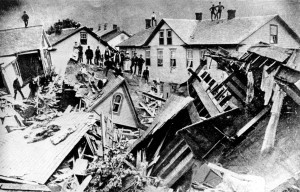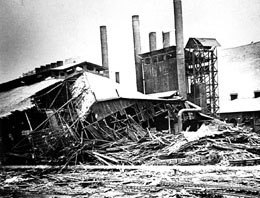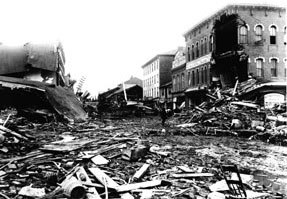drowning
 Over the years, man has tried many ways to harness water. Water is a necessity to life, and without it, all things would die off. Some projects worked out better than others, and some simply needed to be replaced sooner than they were in order to prevent disaster. A good example of that is the earthen dam. An earthen dam is a dam that is built out of rocks and dirt, instead of steel and concrete. Of course, when dams were first built, earthen dams were the only way to go, but after so many failed, a new type of dam had to be designed, in order to save lives. One such failure was the earthen dam built in 1840 on the Little Conemaugh River, fourteen miles upstream from Johnstown, Pennsylvania. Johnstown is sixty miles east of Pittsburgh, in a valley near the Allegheny, Little Conemaugh, and Stony Creek Rivers. The area lies in a floodplain that has had frequent disasters. This time would prove to be one of them. At nine hundred by seventy two feet, this dam was the largest earthen dam in the United States, creating the largest man-made lake at that time…Lake Conemaugh. At a time when here were no railroads in the area for transporting goods, the dam and its extensive canal system was the only way to transport goods to the people, but it became obsolete as the railroads replaced the canal as a means of transporting goods. The canal system was left to become a victim of the elements, and with its neglect, also came the neglect of the dam. In reality, people just didn’t really think anything would happen, and they most likely looked at the dam as just a part of the landscape.
Over the years, man has tried many ways to harness water. Water is a necessity to life, and without it, all things would die off. Some projects worked out better than others, and some simply needed to be replaced sooner than they were in order to prevent disaster. A good example of that is the earthen dam. An earthen dam is a dam that is built out of rocks and dirt, instead of steel and concrete. Of course, when dams were first built, earthen dams were the only way to go, but after so many failed, a new type of dam had to be designed, in order to save lives. One such failure was the earthen dam built in 1840 on the Little Conemaugh River, fourteen miles upstream from Johnstown, Pennsylvania. Johnstown is sixty miles east of Pittsburgh, in a valley near the Allegheny, Little Conemaugh, and Stony Creek Rivers. The area lies in a floodplain that has had frequent disasters. This time would prove to be one of them. At nine hundred by seventy two feet, this dam was the largest earthen dam in the United States, creating the largest man-made lake at that time…Lake Conemaugh. At a time when here were no railroads in the area for transporting goods, the dam and its extensive canal system was the only way to transport goods to the people, but it became obsolete as the railroads replaced the canal as a means of transporting goods. The canal system was left to become a victim of the elements, and with its neglect, also came the neglect of the dam. In reality, people just didn’t really think anything would happen, and they most likely looked at the dam as just a part of the landscape.

By 1889, Johnstown had grown to a population of 30,000 people, many of whom worked in the steel industry…ironically. On May 30, 1889, it began to rain, and continued steadily all day. No one really gave any thought the potential harm so much rain could bring to the nearly sixty year old earthen dam. The dam had a spillway, and so everything seemed safe, but the spillway became clogged with debris, that could not be dislodged. On May 31, 1889, an engineer at the dam saw the warning signs, but the only way to notify anyone was to ride his horse into the village of South Fork to warn the people…a ride that took an eternity in the face of the impending disaster. Nevertheless, it should have been enough time, but the telegraph lines were down, and no warning ever reached Johnstown. At 3:10pm, the dam collapsed with a roar that could be heard for miles. The water, moving at 40 miles per hour barreled down on the towns in it’s path, wiping out everything that got in its way. At Johnstown, 2,200 people lost their lives that day, including one Thomas Knox and his wife. Thomas, like a large number of the flood victims was never found. While I’m not sure that Thomas Knox is related to my husband, Bob Schulenberg’s family, it is quite likely that he is, as there are a number of Thomas Knox’s in the family…though none that I have found so far that died in the Johnstown Flood.
The people in the path of the raging flood waters, were tossed around, along with all that debris, including thirty three train engines that were pulled into the flood waters. I’m sure that for many, death did not come  from drowning, but rather from blunt force trauma. Nevertheless, some people did manage to climb atop the debris, only to be burned alive when much of the debris caught fire, when it was caught in a bridge downstreem and burst into flames. There was a report of a baby that survived on the floor of a house that floated 75 miles downstream, but that was something that was not confirmed. It was during the Johnstown flood, that the American Red Cross handled its first major relief effort. Clara Barton arrived five days after the flood to lead the relief. In the end, it took five years to rebuild Johnstown, which went through disastrous floods in 1936 and 1977. I have to wonder if they should just move the town, but with no major floods since 1977, it’s hard to say.
from drowning, but rather from blunt force trauma. Nevertheless, some people did manage to climb atop the debris, only to be burned alive when much of the debris caught fire, when it was caught in a bridge downstreem and burst into flames. There was a report of a baby that survived on the floor of a house that floated 75 miles downstream, but that was something that was not confirmed. It was during the Johnstown flood, that the American Red Cross handled its first major relief effort. Clara Barton arrived five days after the flood to lead the relief. In the end, it took five years to rebuild Johnstown, which went through disastrous floods in 1936 and 1977. I have to wonder if they should just move the town, but with no major floods since 1977, it’s hard to say.
 What makes a hero? Is it untold bravery in the face of certain death, or is it simply being in the right place at the right time? Yesterday, my grandson, Chris found himself in just such a position. A position that would put Chris between a classmate and death. Chris was in his swimming class, and they were practicing life saving maneuvers. They had brought in another physical education class to help with their life saving class. The students had been told that there was going to be a mock drowning situation and they were going to perform the rescue, and in a perfect world, that is how the exercise would have proceeded. Unfortunately, we don’t live in a perfect world.
What makes a hero? Is it untold bravery in the face of certain death, or is it simply being in the right place at the right time? Yesterday, my grandson, Chris found himself in just such a position. A position that would put Chris between a classmate and death. Chris was in his swimming class, and they were practicing life saving maneuvers. They had brought in another physical education class to help with their life saving class. The students had been told that there was going to be a mock drowning situation and they were going to perform the rescue, and in a perfect world, that is how the exercise would have proceeded. Unfortunately, we don’t live in a perfect world.
The students were all in the water, and Chris noticed a young man who seemed tired and was not swimming very fast. He watched him for a moment, and then his attention was drawn elsewhere. Suddenly someone yelled out in panic from the side of the pool. Chris turned and saw that the young man was under the water and thrashing about. He immediately went into action, performing the maneuvers he had been taught as if on auto-pilot. He brought the young man to the pool’s edge, coughing and sputtering, but alive, and unharmed. We asked Chris what everyone had said afterward, expecting to give him a moment to bask in the glory and admiration that surely followed his heroic act, but in true Chris style, he pretty much blew it off with a simple and humble, “They said good job.” Typical of a hero to act like they didn’t do anything special, when we all know they did.
When Chris told us about the events that transpired at school, I was taken back to my youth. We went swimming every weekday at the Kelly Walsh pool in Casper. I had been going up there for several years, and I had finally reached the great height of 5 feet. To me that meant that I could go into the deep end of the pool, and I went and jumped in, and not right at the edge. When the realization hit me that the water was also 5 feet, putting it at the top of my head, I was already in trouble. As I thrashed around trying to find the edge, I thought I was going to die. Then I came up out of the water gasping for air and saw a girl swimming by. I coughed out the word “help” and she pushed me to the edge of the pool, and once I was there, she simply went on her way. To this day, I can see her face, even though I don’t know her name and could not thank her. I went back to the shallow water…grateful to be alive, and taught myself to swim, because I was never going to be in that position again. Still I would never forget the girl who saved my life.
As I thought about my grandson, who found himself in a position to be that person who saved the life of another person, I knew that he is a true hero. I knew exactly how the young man Chris saved will feel about that event for the rest of his life. It is very hard to forget the face of the person who saw you in a death struggle, and then reached in and pulled you out of death’s grip to safety again. What makes a hero? I know, and I think that young man in Chris’ swimming class yesterday knows too.

